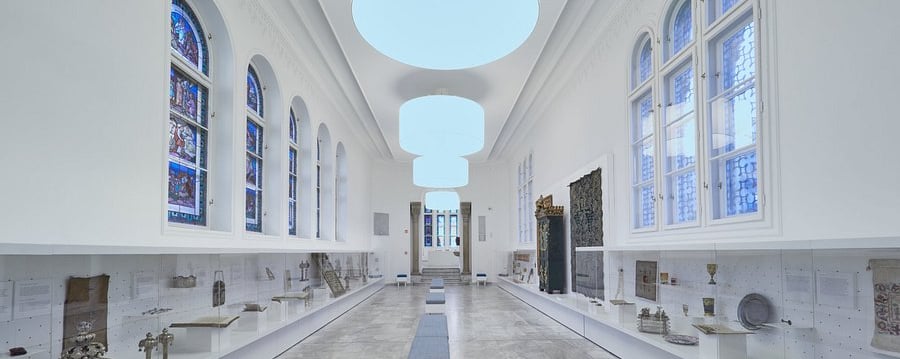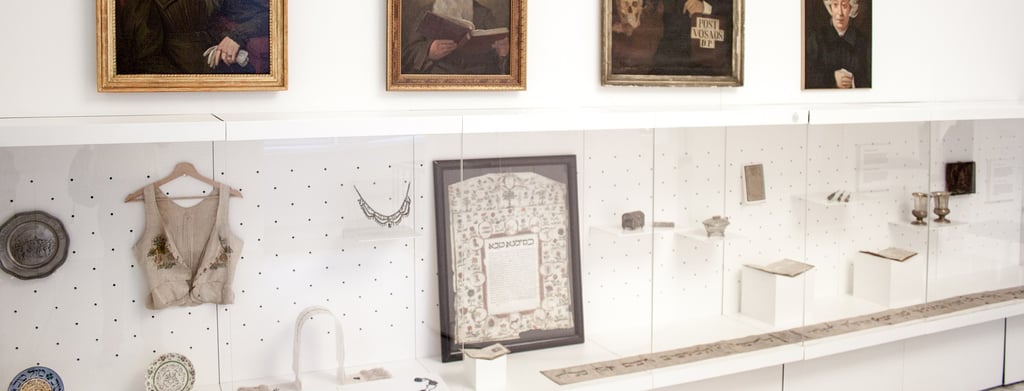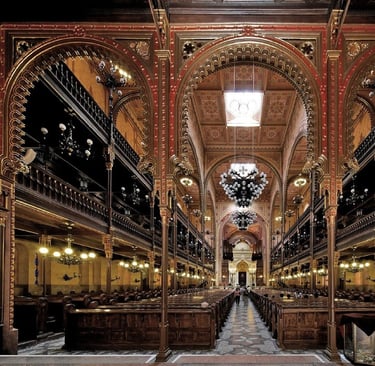Hungarian Jewish Museum and Archives – Budapest: The Soul of a People, Bound in Glass and Ink
Where stained-glass light meets inked parchment, and centuries of Jewish life in Hungary unfold in silent testimony.


Where the Sacred and the Historic Merge
In the very heart of Budapest, where echoes of ancient prayers mingle with the whispers of 20th-century devastation, stands a building that is not only a museum but a sanctified monument to Jewish endurance, creativity, and tragedy. The Hungarian Jewish Museum and Archives, nestled beside the iconic Dohány Street Synagogue, is more than a cultural institution—it is a passage into a world that shaped Hungary and was, in turn, scarred by it.
Here, in the former ghetto of Pest, in a quarter once teeming with bakeries, Hebrew schools, kosher butchers, Yiddish theaters, and prayer halls, a museum quietly safeguards the memory of a people. Not with grand declarations or sterile data, but with parchment and prayer shawls, with torah crowns and handwritten letters, and with the tender pulse of continuity.
A Museum Rooted in Reverence
The origins of the Hungarian Jewish Museum trace back to 1896, the year of Hungary’s millennial celebration. At that time, the Jewish community, officially recognized as a historic religion, sought to affirm its cultural presence in a country it had long called home. The museum’s first collection was housed in modest quarters downtown, driven by the meticulous collecting of artifacts that testified to the religious, social, and intellectual life of Hungarian Jews.
In 1932, a more permanent home was created: a building intentionally designed to mirror the architectural style of the adjacent synagogue—Moorish Revival, layered with arches and ornate flourishes, not unlike the synagogues of North Africa and the Iberian Peninsula. The symbolism was profound: the museum was to be not an isolated archive, but an extension of the synagogue, as inseparable from prayer as memory is from faith.
Through the Glass and Into the Past
Step inside, and the first thing that greets you is the light—not just sunlight, but light filtered through stained glass, casting the museum’s interior in soft, sacred hues. This interplay of color and shadow is not mere decoration; it is an allegory. Jewish life in Hungary has always been a balance of illumination and obscurity, flourishing creativity and brutal repression.
In the display cases, one finds a world so rich, so intricately alive, it defies the notion of history as something distant. There are Torah scrolls so old their parchment sighs with age, and kiddush cups engraved with names long erased by war but revived in silver. There are rimonim (Torah finials) from 17th-century Ottoman Hungary, glowing with Eastern influence. There is even a Roman-era gravestone, inscribed with Hebrew and Latin—Hungary’s earliest known Jewish artifact, a bridge between empire and exile.
Each artifact is an ember from a once-roaring fire.
The Archives: Hungary’s Jewish Memory Bank
Beyond the museum’s public displays lies one of Europe’s most comprehensive Jewish archives. The Hungarian Jewish Archives, managed under the same institution, houses documents from the 18th century to the present. It is a textual tapestry of synagogue minutes, birth records, marriage contracts, community bylaws, tax documents, newspaper clippings, rabbinical letters, Zionist correspondence, Holocaust testimonies, and more.
This is not a place for passive viewing. Scholars, descendants, genealogists, and theologians from around the world come here to trace roots, unravel mysteries, and reclaim voices. The archives are a living repository—not dusty shelves, but veins of information that reconnect families separated by time and trauma.


From Glory to Ghetto
No visit to this museum is complete without acknowledging the pain etched into its very stones. In 1944, the Dohány Street Synagogue and the surrounding buildings became part of the Budapest Ghetto, where over 70,000 Jews were imprisoned, starved, and marked for death.
The museum building—designed for education—was suddenly a site of desperation. Amid deportations, Allied bombings, and starvation, the museum’s staff risked their lives to hide artifacts in the cellar. Remarkably, much of the original collection survived. But outside its walls, over 600,000 Hungarian Jews perished in the Holocaust—one of the highest proportional losses in Europe.
The museum does not flinch from this. It includes a detailed, deeply moving section dedicated to the Holocaust, not only the facts, but the faces: diaries from children, prayer books found in death camps, synagogue torahs buried and later unearthed.
Culture, Faith, and Identity
The museum is not only about persecution—it’s also about expression. Its exhibits trace how Hungarian Jews contributed to and transformed culture: in literature, medicine, law, music, and architecture. Jewish musicians helped create Hungary’s classical music tradition. Jewish publishers fostered Budapest’s golden age of journalism. Jewish merchants and bankers built industries and bridges.
There is even a reconstructed Jewish kitchen, its humble utensils a reminder that culture resides in the domestic as well as the divine. You see children’s toys beside prayer books, wedding canopies near military uniforms. The variety of life on display is a quiet rebuke to those who tried to define Jewish identity in narrow terms.
This museum shows Jewish Hungary in full bloom—not just as a victimized group, but as a vibrant, evolving civilization within a civilization.
Education and Outreach
The museum is a vital part of Hungary’s educational system. It hosts regular school tours, Holocaust awareness programs, teacher workshops, and public lectures. It also publishes research, curates traveling exhibitions, and participates in international Jewish heritage initiatives.
Its mission is not merely to preserve, but to engage—to ensure that young Hungarians understand not just what was lost, but what was created, and why it matters.
The museum also collaborates closely with other institutions, including the Jewish Museum Berlin, Yad Vashem, and the Museum of the Jewish People in Tel Aviv. Through these relationships, Budapest remains a hub of Jewish memory.


Practical Information
If you are visiting Budapest and wish to go beyond the postcard views, if you want to feel the soul of the city, then walk the narrow streets of the Jewish Quarter and step through the threshold of the Hungarian Jewish Museum and Archives.
Here’s everything you need to know:
Address
Hungarian Jewish Museum and Archives
Dohány utca 2
1077 Budapest, Hungary
Located directly next to the Dohány Street Synagogue, this museum is easily reached by Metro Line 2 (Astoria Station) or by a scenic walk from Deák Ferenc Square.
Opening Hours
Monday to Thursday: 10:00 AM – 6:00 PM
Friday: 10:00 AM – 4:00 PM
Saturday: Closed (Shabbat observance)
Sunday: 10:00 AM – 6:00 PM
Note: The museum is closed on Jewish holidays. Always check their calendar before visiting.
Ticket Prices (as of 2025)
Tickets typically include access to the museum, the synagogue, the Heroes’ Temple, the cemetery, and the Holocaust memorial.
Adults: 4,500 HUF (~$12.50 USD)
Students (ages 6–26): 3,000 HUF (~$8.40 USD)
Seniors (ages 62–70): 3,000 HUF
Children under 6 and adults over 70: Free
Family ticket (2 adults + children): 10,000 HUF (~$28 USD)
Guided Tours (optional):
In English or Hebrew: 2,500 HUF (~$7 USD) per person
Audio guides are available in multiple languages for a small additional fee.
Accessibility
The museum and synagogue are wheelchair accessible. Elevator access is available, and staff are trained to assist visitors with mobility needs. Printed and digital materials are offered for those with visual or auditory impairments.
Contact Information
Phone: +36 1 343 0420
Email: info@milev.hu
Official Website: https://www.milev.hu/
Social Media
Facebook: facebook.com/milev.hu
Instagram: Currently not active
YouTube: Occasional uploads under “Magyar Zsidó Múzeum és Levéltár”








